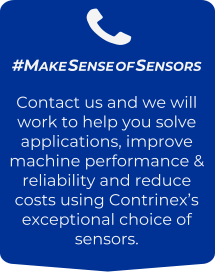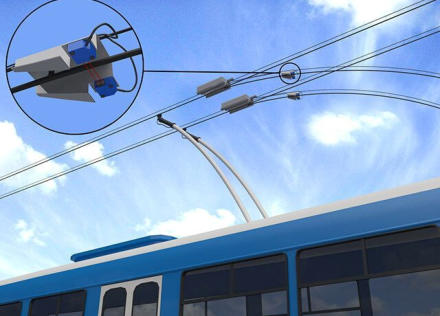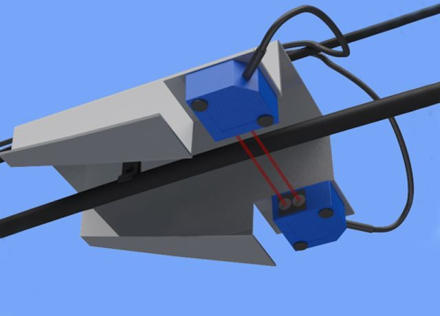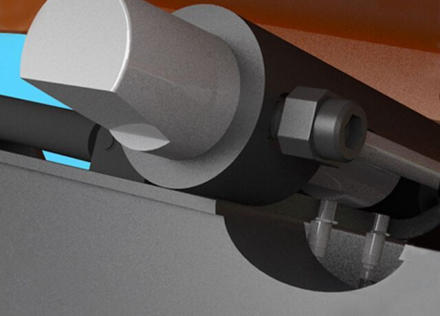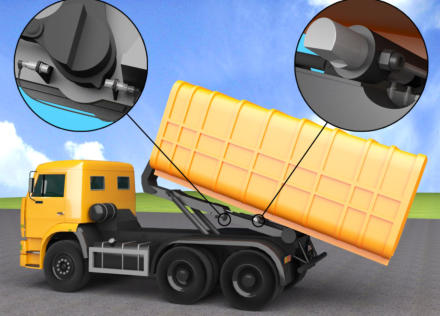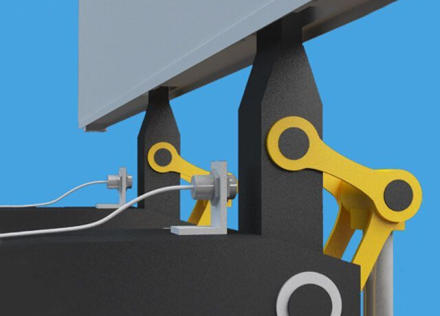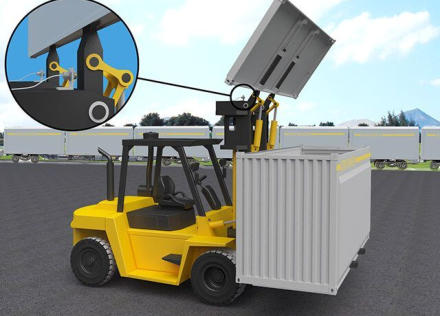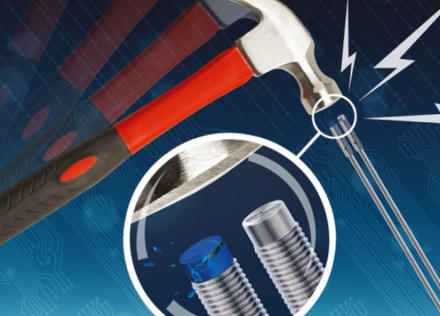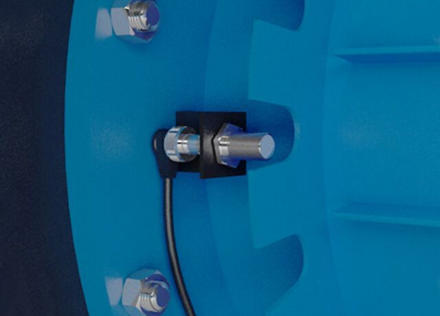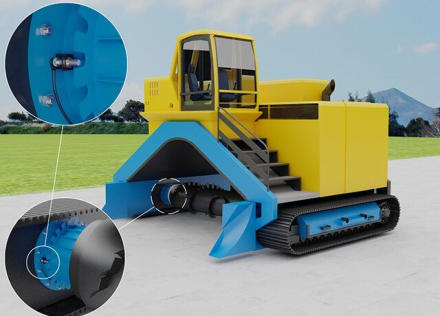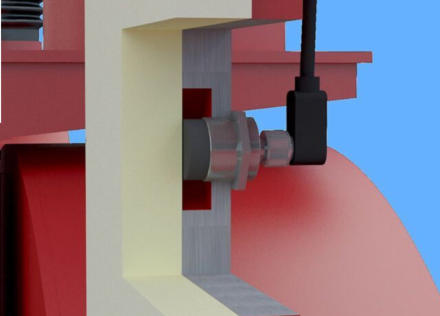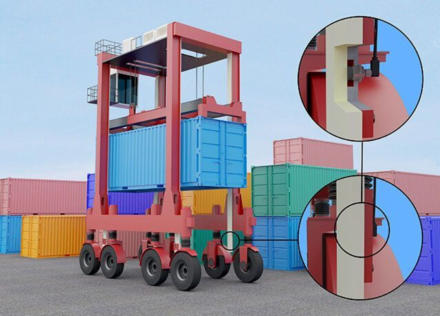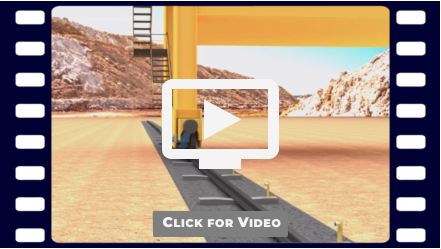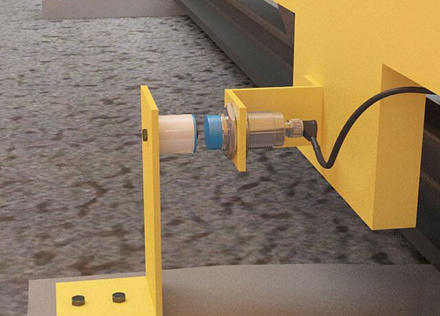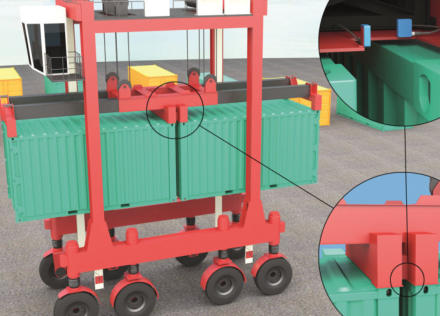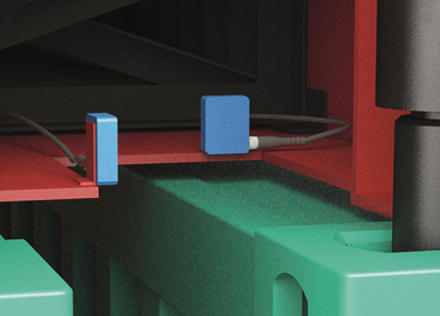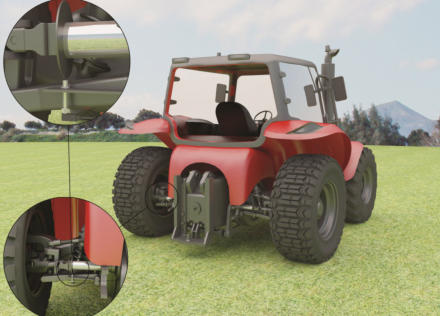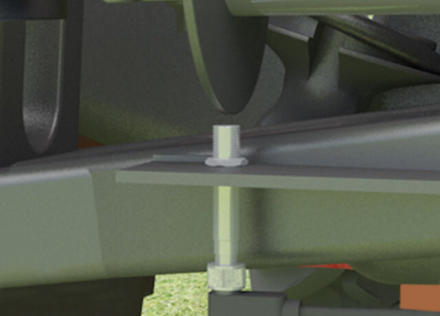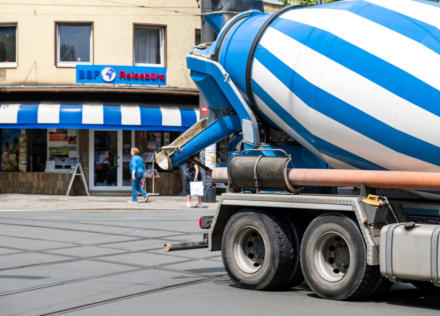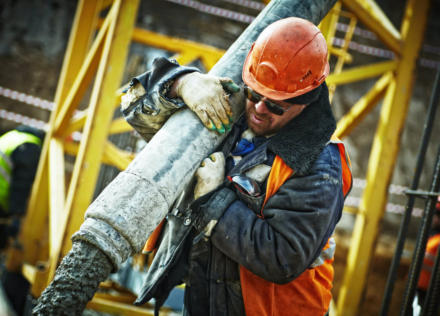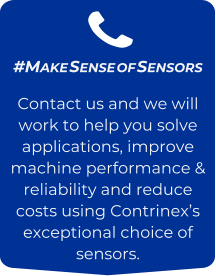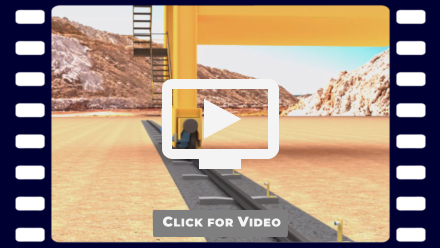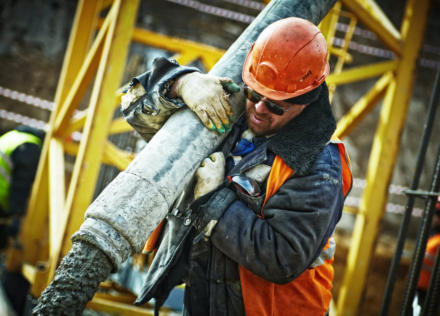(0121) 58 222 58 SALES@PLUSAUTOMATION.CO.UK

© 2021 - PLUS Automation Limited®

HELPING YOU #MAKE SENSE OF SENSORS
--









EXAMPLE APPLICATIONS
TO ILLUSTRATE THE WIDE-VARIETY OF APPLICATIONS SOLVED USING CONTRINEX SENSORS, WE HAVE POSTED A LARGE SELECTION OF EXAMPLE APPLICATIONS WHICH CAN BE SEEN BY CLICKING ON AN IMAGE. BELOW ARE A SELECTION OF SOME OF THESE APPLICATIONS:



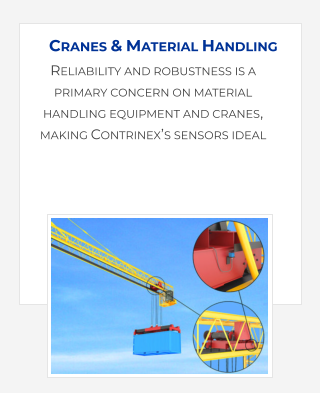
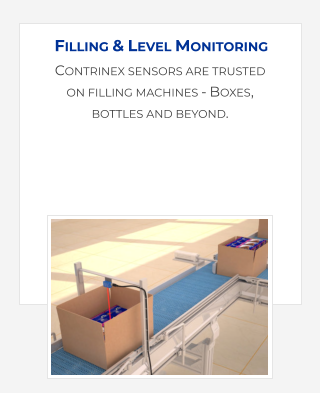
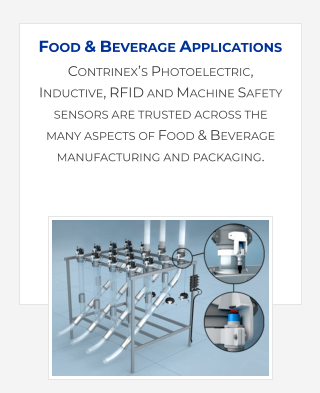
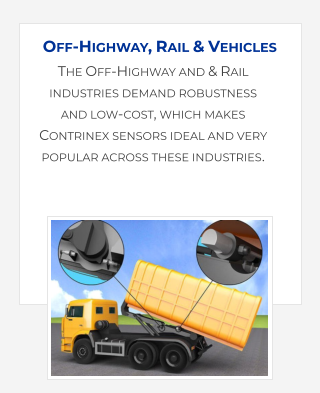
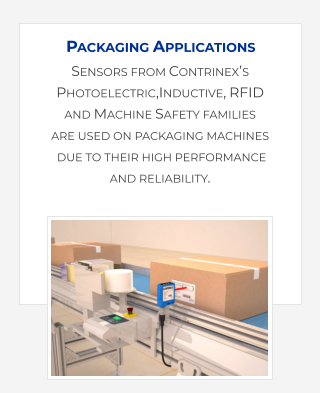
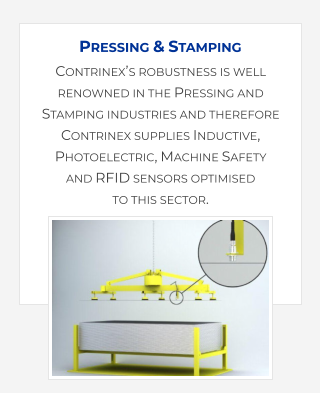
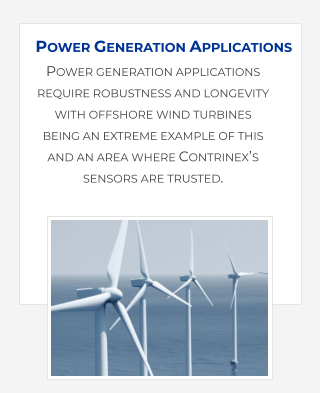
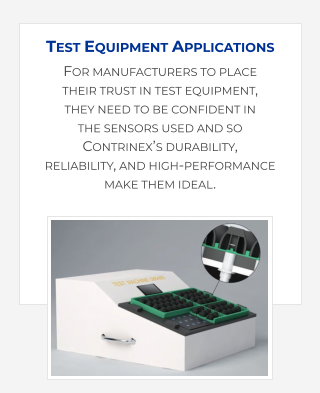

CUSTOMER VALUES
RELIABLE, EXCEPTIONAL RELIABILITY IN A HARSH OUTDOOR
ENVIRONMENT
AUTOMATIC OPERATION WITH OPTIMAL SPACE UTILISATION
ELIMINATION OF SWITCHING ERRORS DURING YEAR-ROUND
OPERATION
SIGNIFICANTLY REDUCED MAINTENANCE COSTS
PRODUCT ADVANTAGES
SENSING RANGE UP TO 12,000 MM
LONG SENSING RANGE IN SMALL SENSOR
EXCEPTIONAL RESISTANCE TO VIBRATION DURING OPERATION
When a tram reaches a road junction, wire-switches, installed
on the overhead conductor cables, control its direction of
travel, with switches in either the default “straight-through” or
“turnout” positions. As the tram passes a switch in the turnout
position, Contrinex photoelectric sensors mounted on the
overhead cables detect the presence of the pantograph
current collector so that the control system can then reset the
switch to the default position.
CUSTOMER APPLICATION
In urban tram transportation systems, wire-switches installed
on the overhead conductor cables at road junctions, control
the direction of travel for the trams. The switches default to the
straight-through position so that when a bus approaches a
turn, the driver uses a remote trigger to change the switch to
the turnout position. After the bus completes the turn, the
switch reverts to the straight-through position.
If a triggered switch reverts to the straight-through position
prematurely, the pantagraph current collector may become
disengaged, damaging the switch. Therefore tram operators
install safety systems to prevent premature switching.
Typically, these utilise timer circuits and a predetermined delay
or mechanical sensors that rely on physical contact with the
current collector, but neither system is reliable.
A Swiss manufacturer of trolley-bus control systems requires a
highly reliable, rugged sensor system that will detect the
presence of a current collector as it passes a switch. The
system must operate with minimal maintenance and
withstand the varied weather conditions of an outdoor
environment in Switzerland and therefore they selected
Contrinex sensors.
.
Customer Solution
Contrinex’s C23 through-beam photoelectric sensors offer
high-performance, small size and high-stability. A purpose-
designed metal bracket, mounted above the conductor cable,
holds the transmitter and receiver units in alignment on either
side of the cable. As the pantagraph current collector passes
between the two units it breaks the beam, triggering the
sensor and returning the switch to the straight-through
position.
The C23 photoelectric sensors are virtually impervious to the
harsh, outdoor environment and their small physically size (30
x 20 x 10mm) eliminates the risk of accidental damage arising
from a mechanical collision. The rugged construction and
vacuum-encapsulated electronics within the sensor minimise
the effects of vibration, ensuring a long service life.
Each unit is connected to the trolley-bus control systems via a
PVC-sheathed cable with a hermetically sealed entry. The
receiver has an industry-standard PNP interface. The one-
piece mounting bracket allows easy removal and replacement
of the complete assembly during routine maintenance.
Operational results have been excellent and the Contrinex
sensors have proved highly reliable, eliminating switching
errors and reducing maintenance costs significantly.
These rugged miniature sensors have a sensing range up to
30m, for Through-beam applications. They are very reliable
and cost-effective with the additional benefit of offering a
range of low-cost stainless-steel mounting and protection
brackets, making them ideal for a wide variety of applications.

CUSTOMER VALUES
ELIMINATION OF HUMAN ERROR PREVENTS TRUCK BEING
DRIVEN IN AN UNSAFE CONDITION.
HIGHLY RELIABLE SENSING PERFORMANCE IN HIGHLY
DEMANDING CONDITIONS
CORROSION-RESISTANT SENSORS WITHSTAND WATER, ICE,
MUD AND SALT
HIGHLY COST-EFFECTIVE SOLUTION TO A POTENTIALLY
SERIOUS PROBLEM
PRODUCT ADVANTAGES
EXTREMELY ROBUST, IMPACT AND ABRASION RESISTANT IP68/
IP69K RATED HOUSING.
CORROSION-RESISTANT, V2A/ AISI 304 STAINLESS-STEEL,
FOOD-COMPATIBLE BODY.
LONG OPERATING DISTANCE OF 7MM IN A SMALL & SLIM
STAINLESS-STEEL 20X 32X 8MM HOUSING.
ROBUST, METAL-CASED INDUCTIVE PROXIMITY SENSORS
SUITABLE FOR EASY INTEGRATION
FACTOR 1 - CONSISTENT SENSING, IRRESPECTIVE OF WHETHER
THE TARGET IS STEEL OR ALUMINIUM.
RELIABLE, COMPACT VIBRATION-RESISTANT SENSORS
IO-LINK INTERFACE INCLUDED – IDEAL FOR INDUSTRY 4
Hook loader trucks utilise a hydraulic system for loading and
unloading a demountable container. Once the container is
correctly positioned on the vehicle’s load bed, interlocks
engage with its base, securing it in position. Contrinex’s
rugged sensor systems detect full engagement of the
interlocks, ensuring the truck is safely loaded prior to driving
away. Therefore, the sensors must be mechanically robust and
able to withstand harsh outdoor conditions.
CUSTOMER APPLICATION
A specialist vehicle builder manufactures hydraulic hook-lift
systems for commercial trucks. A hook loader truck employs a
series of hydraulic rams to hook, lift and pull a demountable
container onto the vehicle’s load bed; a full container may
weigh up to 30 tons.
Hook loader trucks operate all year round, often in harsh
environments such as demolition and construction sites.
Hook-lift systems are typically semi-automated. The driver
positions the truck, engages the hook with the container and
initiates the lifting sequence. Once the container is pulled onto
the load bed, two interlock mechanisms, mounted on the
truck chassis, actuate and engage with the container body.
Once the interlocks are fully engaged, the container is secure
and the truck may be driven safely.
A highly reliable sensor system must detect the position of the
interlocks, ensuring that they are fully engaged before the
truck drives away. Sensors must be robust and must withstand
water, mud, dirt and ice. They may also be subject to
mechanical shock and vibration.
CUSTOMER SOLUTION
Rugged Full stainless-steel inductive sensors from the
Contrinex Extreme 700 Series are designed for demanding or
even exceptionally demanding environments, making them
ideal for this application. Highly reliable and IP68 / IP69K rated,
these embeddable units feature one-piece V2A (AISI 304)
stainless-steel construction with vacuum-encapsulated
electronics, making them well suited to the hostile operating
conditions.
During operation, a double-ended ram drives a pair of
interlock bolts into position. On either side of the truck, two
M18-diameter sensors are mounted in the wall of each bolt
housing; one detects the bolt as it reaches the fully engaged
position; the other detects it in the fully retracted position. A
second ram drives a rotating lock mechanism to engage with
the vehicle chassis; a further two sensors detect the position of
a cam on the locking shaft as it rotates.
Each sensor is configured with an industry-standard PNP
normally-open interface, and connection to the truck’s
hydraulic control system is via an integral M12 connector and
PUR-sheathed cable. This allows easy removal and
replacement during routine maintenance.

CUSTOMER VALUES
SAFE, RELIABLE PERFORMANCE IN A DEMANDING OUTDOOR
ENVIRONMENT
NO LIKELIHOOD OF ACCIDENTAL DAMAGE ARISING IN
OPERATION
COST-EFFECTIVE SOLUTION, MAINTENANCE FREE
PRODUCT ADVANTAGES
CORROSION-RESISTANT STAINLESS-STEEL SENSOR RATED TO
IP68 AND IP69K
COST-EFFECTIVE HIGH-PERFORMANCE SENSOR WITH
EXCEPTIONAL RELIABILITY
BEST-IN-CLASS 20MM SENSING DISTANCE IN M30-DIAMETER
HOUSING
CUSTOMER SOLUTION
Contrinex inductive sensors are robust, reliable and offer
extended sensing distances; the Full Inox Extreme range is
ideal for this application. A one-piece M30-diameter stainless-
steel body and vacuum-encapsulated electronics make this
device particularly suitable for the mechanically demanding
environment, and the sensing distance of 20mm eliminates
any possibility of accidental collision in operation.
A metal bracket is mounted externally on the actuating
mechanism for the upper forks; the embeddable sensor is
mounted immediately adjacent to one of the forks and detects
the position of the actuating arm as it drives the fork into the
vertical position. The AISI 303/V2A stainless-steel housing and
sensing face are corrosion-resistant and impervious to water
ingress; the sensor is IP68- and IP69K-rated.
Configured with an industry-standard PNP normally-open
interface, the Contrinex M30 Extreme sensor connects to the
forklift’s lower-fork tilt-control systems via a flexible PUR-
sheathed cable. A sealed cable entry ensures fit-and-forget
capability during extended periods of operation in an outdoor
environment.
The Full Inox inductive sensor detects the vertical position of
the forklift’s upper forks effectively and repeatably, ensuring
safe, reliable operation of the unloading system. Contrinex
inductive sensors deliver a cost-effective solution that satisfies
the customer’s requirements for extreme robustness and
extended sensing distance.
A container manufacturer uses a modified forklift, fitted with
two sets of forks, for unloading bulk cargo. The lower forks
support the container while the upper forks control the lid.
When unloading, the lid opens and the lower forks rotate,
tipping out the contents. A robust inductive sensor senses the
position of the lid, ensuring it opens fully before emptying.
CUSTOMER APPLICATION
Containers are often used when transporting bulk cargo,
including wood chip and biomass, by rail. A manufacturer of
bulk-cargo containers has developed an innovative unloading
system that uses only a modified forklift, eliminating the need
for specialist handling equipment.
The forklift has two pairs of lifting forks. The main forks,
mounted conventionally, support the weight of the container
as it is unloaded from a freight wagon; a second pair, mounted
vertically above the lower pair, opens and closes the lid of the
container. During opening, the upper forks lift the lid a short
distance before tilting it vertically, leaving the top of the
container completely unobstructed.
The lower forks then rotate about a horizontal axis, tilting the
container end-over-end and tipping the contents out. A robust
and reliable sensor system is required to detect the vertical
position of the lid before rotation begins. An extended sensing
distance is essential to eliminate the possibility of mechanical
damage.

CUSTOMER VALUES
RELIABLE, CONTINUOUS SPEED MONITORING IN HARSH
ENVIRONMENT
FIT-AND-FORGET SENSOR SOLUTION
EFFICIENT, COMPACT DESIGN POSSIBLE FOR MOBILE TURNING
MACHINE
NO SENSOR-RELATED DOWNTIME• NO REPAIR COSTS THANKS
TO EXCEPTIONALLY LONG SENSOR LIFE
PRODUCT ADVANTAGES
EXTREMELY ROBUST, IMPACT AND ABRASION RESISTANT IP68/
IP69K RATED HOUSING.
CORROSION-RESISTANT, V4A/ AISI 316L STAINLESS-STEEL,
FOOD-COMPATIBLE BODY.
LONG OPERATING DISTANCE OF 7MM IN A SMALL & SLIM
STAINLESS-STEEL 20X 32X 8MM HOUSING.
ROBUST, METAL-CASED INDUCTIVE PROXIMITY SENSORS
SUITABLE FOR EASY INTEGRATION
FACTOR 1 - CONSISTENT SENSING, IRRESPECTIVE OF WHETHER
THE TARGET IS STEEL OR ALUMINIUM.
RELIABLE, COMPACT VIBRATION-RESISTANT SENSORS
IO-LINK INTERFACE INCLUDED FOR FREE – IDEAL FOR
INDUSTRY 4
Agriculture is using increasingly complex automation in its
machinery and an example application is in composting
machines. Contrinex’s uniquely robust V4A/ 316L stainless-steel
sensors are relied upon for operating reliably in the
challenging environment of the inside of the machine’s drive
rotor. Withstanding dust, humidity and high temperatures, the
sensors enable the machine to provide the fast drying of
materials and optimal decomposition with reliable sanitisation
being ensured.
CUSTOMER APPLICATION
The efficient turning of organic materials – loosening, lifting
and aerating – is vitally important in industrial composting.
Special mobile equipment ensures fast drying of materials,
optimal decomposition and reliable sanitisation, processing
between 500 and 6800 cubic metres of earth per hour.
A manufacturer has introduced machine speed monitoring by
sensor. A sensor located in the rotor counts the passing teeth
of a rotating mechanical disk. From the number of teeth per
second, the controller then calculates the final speed.
Perfect sensor operation is required under these particularly
harsh conditions. In addition to permanent vibration and
shaking, the inductive sensor is also constantly exposed to
dust, moisture, and temperatures from 70 to 80°C (158 to
176°F). Since the location of the sensor in the rotor is hard to
access, the sensor must be very durable and low maintenance
to avoid time-consuming repairs.
CUSTOMER SOLUTION
Contrinex inductive sensors from the FULL INOX family,
Washdown range, are perfect for this application. Made from a
single piece of V4A stainless steel, including the sensing face,
they have no covers, caps or welding seams and are the most
robust inductive sensors on the market. They resist shock,
vibration, impact and abrasion and almost any exposure to
dirt, gases, or liquids such as oil, water and cleaning agents.
Functionally stable at temperatures from -25 to +85°C (-13 to
185°F), they are also insensitive to core breakage.
Thanks to the long operating distances of these sensors (three
times greater than the norm) a compact and efficient design
was possible using the M12 size. A long operating distance
allows the sensor to be mounted well away from the rotating
disk’s passing teeth. Setup is also straightforward, as
installation tolerances are less critical. A sensor version with
plug connector was chosen to allow speedy replacement if
necessary.

CUSTOMER VALUES
MAXIMUM VEHICLE UTILISATION WITH FEWER CONSTRAINTS
ON OPERATIONS
REAL-TIME INDICATION OF BEARING CONDITION AND WEAR
RATE
REDUCED MAINTENANCE COSTS WITH MINIMAL INCIDENCE OF
BREAKDOWNS
RELIABLE OPERATION IN A HIGHLY DEMANDING AND HARSH
ENVIRONMENT
PRODUCT ADVANTAGES
ANALOGUE DEVICE WITH EXTENDED 40MM SENSING RANGE
SMALL PHYSICAL SIZE (LESS THAN 50MM LENGTH)
EXCEPTIONAL ACCURACY AND RESOLUTION IN THE MICRON
RANGE
LONG LIFE, ESPECIALLY IN APPLICATIONS WITH TEMPERATURE
FLUCTUATIONS AND VIBRATIONS
Busy container seaports rely upon the ‘24/7’ operation of
specialist container-handling vehicles called Straddle Carriers
for loading, unloading and stacking containers. Often located
at ports, being beside the sea can mean that they have to work
in an aggressive and corrosive environment, requiring
frequent maintenance.
Because traditional, interval-based maintenance schedules are
not optimally efficient, condition-based intervention systems
which minimise the risk of breakdown, are popular. European
port operators therefore frequently rely upon Contrinex’s
rugged, analogue-output inductive sensors to monitor
components with a high risk of premature failure, maximising
vehicle utilisation and reducing maintenance costs.
CUSTOMER APPLICATION
A fleet of straddle carriers services a busy container port,
operating round the clock in a highly aggressive environment.
Frequent maintenance is necessary, but traditional, interval-
based maintenance schedules are not always optimal.
Condition-based intervention minimises the risk of
breakdowns, while imposing fewer constraints on day-to-day
operation; it also incurs cost only when necessary.
As a carrier moves over a container, a central spreader beam
lowers and locks onto the four corner fittings of the container.
Plain plastic bearings on the carrier legs guide the container as
it is raised; there is significant contamination from dirt and
other debris. Bearings wear rapidly in the all-weather
operating conditions.
A condition-monitoring system must measure bearing
thickness, repeatably and accurately, in realtime and with µm
resolution. Sensors must operate reliably in the harsh
environment with a minimum rating of IP67. Sensor length
must not exceed 70mm and a minimum sensing range of
30mm is mandatory.
CUSTOMER SOLUTION
Contrinex’s Analogue Inductive sensors, which feature ‘Extra
Distance’ technology are ideal for this demanding application.
These M30-diameter metal-bodied devices are IP67-rated and
provide an analogue voltage (0 to 10 volt) or current (4 to
20mA) output. The sensors are less than 50mm long with a
40mm sensing range, comfortably exceeding the specified
requirement.
A mild steel mounting plate, fixed immediately behind the
plastic bearing, locates each sensor with its sensing face in
contact with the rear surface of the bearing. As a container
passes over the front face of the bearing, the sensor measures
the distance to the metal container wall, and thus the bearing
thickness. Data is collected in real time with exceptional
accuracy and resolution in the micron range.
Data passes to on-board computers mounted on each carrier;
connection is via a flexible cable with an easily detachable M12
connector. At intervals, carriers transmit data wirelessly to a
central processor for detailed analysis.
The output gives a clear indication of the condition and wear
rate of each bearing, identifying any carrier requiring
maintenance. Consequently, the port operator has the means
to develop a genuine commercial advantage by eliminating
compromise from day-to-day operating processes

CUSTOMER VALUES
UNINTERRUPTED PRODUCTION AS POSITIONAL
IDENTIFICATION IS HIGHLY RELIABLE.
NO RISK OF SKEWING AS MOVEMENT OF THE MACHINE
STRUCTURE IS SYNCHRONISED.
ELIMINATION OF COLLISION DAMAGE BECAUSE OF SENSING
DISTANCE UP TO 45MM.
PRODUCT ADVANTAGES
PASSIVE RFID TRANSPONDER TAGS REQUIRE NO POWER
SOURCE AND MINIMAL MAINTENANCE.
RUGGED RFID TRANSPONDER TAGS WITH NYLON OR ALL-
METAL HOUSINGS SEALED TO IP67.
CONIDENT® TECHNOLOGY PROVIDES EXTENDED SENSING
RANGE ≤ 45MM.
READ/WRITE UNITS INTERFACE WITH A CHOICE OF INDUSTRY-
STANDARD CONTROL SYSTEMS OR IO-LINK
CUSTOMER SOLUTION
Contrinex high-frequency RFID read/write modules and
30mm-diameter RFID transponder tags are ideal for this
application. Rated up to IP67, the M30-diameter read/write
modules have PBTP sensing faces and V2A stainless-steel
housings, making them ideal for the demanding environment.
The ConIdent® passive transponders require no internal power
source and, with PBTP synthetic housings, have the same IP67
rating. The selected combination provides read/write distances
of up to 45mm (nearly 2 in), ideal for the specified operating
conditions. Tags are mounted at one-meter intervals along
each travel rail, each programmed with a unique identification
number.
As the machine passes a tag, the read/write module reads its
identification number at high speed; this is transmitted via a
PROFIBUS DP interface to the customer’s control system. A
simple look-up table confirms the location of the tag and thus
the position of the machine, allowing movement of both sides
of the structure to be synchronized without skewing.
Operation is independent of the direction of travel.
Contrinex ConIdent® RFID devices allow accurate and highly
reliable sensing of machine position and the long sensing
distance avoids any risk of collision damage. The customer
enjoys extended service life and robustness not available from
alternative position-detection systems, together with excellent
value for money
A manufacturer of bulk material-handling equipment uses
Contrinex Radio Frequency IDentification (RFID) technology to
sense the position of a large rail-mounted reclamation-
conveyor operating in a hot, dusty environment. A pair of read-
write modules, mounted on the machine structure,
interrogates a series of RFID tags, positioned at one-meter
intervals along each travel rail. The control system identifies
each tag individually and determines the exact position of the
machinery.
CUSTOMER APPLICATION
During surface-mining operations, large mobile reclamation
machines are used to recover bulk materials. On each
machine, a bucket-wheel excavator collects material and
deposits it onto a conveyor. As an area is cleared of material,
the machine moves along parallel steel travel rails to the next
area, allowing continuous operation without interruptions for
machine repositioning.
The distance between the travel rails is around 100 metres (300
ft) and travel speeds may reach 2m/sec (4.5 mph). If machine
movement along the two rails is not controlled accurately, the
two sides of the structure become misaligned, causing the
machine to skew. In this event, production is halted while the
machine is realigned; in the worst case, costly damage occurs.
A sensing system is required that detects the position of each
side of the machine structure accurately and reliably along the
entire length of the travel rails, allowing coordinated control of
the drive systems. Sensors must accommodate up to 10mm
lateral movement of the machine structure across either rail
and must withstand the hot, dusty environment of a desert
climate.
I

CUSTOMER VALUES
NON-CONTACT, ALL-ELECTRONIC DEVICE WITH SENSING
RANGE UP TO 500MM.
LARGE SENSING RANGE AVAILABLE IN A PHYSICALLY SMALL
SENSOR.• EXCEPTIONAL RESISTANCE TO EXTREME VIBRATION
DURING OPERATION.
OPTIMAL SPACE UTILISATION WITH LITTLE OR NO RELIANCE
ON OPERATOR INVOLVEMENT
PRODUCT ADVANTAGES
ELIMINATION OF CALIBRATION ERRORS DURING NORMAL
OPERATION
LARGE SENSING RANGE AVAILABLE IN PHYSICALLY SMALL
SENSOR
PROVIDES RELIABLE, REPEATABLE SENSING IN DEMANDING
OPERATING CONDITIONS
At busy container seaports, purpose-designed container-
handling vehicles called Straddle Carriers, operate around the
clock, loading, unloading and stacking containers. Space
utilisation is increasingly important and correctly identifying
the size of container picked for each lift is essential for
efficiency.
Contrinex photoelectric sensors have been fitted to the
Straddle Carriers to detect the container size and eliminate the
need for drivers to carry out identification checks, saving time
and avoiding errors.
CUSTOMER APPLICATION
A fleet of straddle carriers, purpose-designed container-
handling vehicles, services a busy French container port. As a
straddle carrier moves over a container, a central lifting beam
lowers and locks onto the corner castings of the container;
each lift comprises either a single 40-foot container or two 20-
foot containers.
Optimal utilisation of storage space is essential; correctly
identifying the size of container picked for each lift is vital.
Fitting carriers with sensors that detect the size and type of
containers at the time of lifting eliminate the need for drivers
to carry out identification checks, saving time and avoiding
errors.
The original mechanical sensors proved unreliable, losing
calibration when subjected to continuous vibration during
normal operation. Although the scheduled maintenance
interval for each vehicle is 1,000 hours, mechanical sensors
required recalibration at intervals of no more than two or three
days. A highly stable replacement sensor system was required.
CUSTOMER SOLUTION
Highly stable, non-contact, all-electronic units from the
Contrinex range of photoelectric sensors provide a reliable and
cost-effective alternative. The moulded-resin sensor casings,
fitted with coated-plastic sensing faces, are IP67 rated, making
them virtually impervious to the harsh, salt-laden environment
of a busy container port. Connection to the vehicle’s control
systems is via an integral M12 connector and PVC-sheathed
cable, allowing easy removal and replacement during routine
maintenance.
To confirm the size of the container, two pairs of diffuse
sensors with background suppression are mounted centrally
on each lifting beam. As the lifting beam descends, one sensor
from each pair detects the presence or absence of corner
castings at the central lifting points, while the other detects
the presence or absence of the gap between two 20-foot
containers. The combination of the two eliminates incorrect
identification in the unlikely event that the first sensor returns
a false-positive signal from a 40-foot container.
A physically small housing and long sensing distances
eliminate the risk of accidental damage arising from a
mechanical collision, while rugged industry-standard housings
and vacuum-encapsulated electronics minimise the effects of
vibration.
Operational results have been excellent; the new Contrinex
sensors have eliminated calibration errors and reduced
maintenance costs significantly.
A range of multi-purpose off-road tractors allows the driver to
choose between two-wheel or four-wheel steering. When
selecting two-wheel steering using the front wheels only, the
rear axle is locked in the straight-ahead position. Before the
axle is locked, rugged inductive sensors from Contrinex detect
the straight-ahead position accurately and reliably, ensuring
precise alignment of the tractor’s steering geometry.
CUSTOMER APPLICATION
Modern multi-purpose off-road utility vehicles are
exceptionally versatile, offering four-wheel drive and both front
and rear-wheel steering. Reliable operation all year round, on
all types of terrain and in all weather conditions, is essential as
typical tasks include bulk-load transportation and agricultural
engineering.
Extreme conditions often demand increased manoeuvrability;
for maximum control, the driver can engage four-wheel
steering when required. When reverting to the default two-
wheel steering configuration, the rear axle must be locked in
the straight-ahead position to prevent misalignment of the
rear wheels.
A rugged, reliable and accurate sensor system is required to
detect the straight-ahead position of the rear axle before it is
locked. The sensor must withstand significant mechanical
shock and vibration and must also be impervious to water
ingress. Additionally, it should accommodate the extremes of
temperature experienced during all-year-round operation.

CUSTOMER VALUES
RELIABLE, REPEATABLE SENSING PERFORMANCE IN
DEMANDING OPERATING CONDITIONS
FIT-AND-FORGET OPERATION WITH MINIMAL MAINTENANCE
TECHNICALLY ELEGANT, COST-EFFECTIVE SOLUTION
REQUIRING MINIMAL RE-ENGINEERING
PRODUCT ADVANTAGES
2MM SENSING DISTANCE ELIMINATES THE POSSIBILITY OF
ACCIDENTAL DAMAGE TO THE SENSOR
RUGGED, ROBUST STAINLESS-STEEL SENSOR WITH INTEGRAL
M8 CONNECTOR
AFFORDABLE HIGH-PERFORMANCE SENSOR WITH
EXCEPTIONAL RELIABILITY - FIT-AND-FORGET OPERATION
WITH MINIMAL MAINTENANCE
Configured with an industry-standard PNP normally-open
interface, the sensor features an integral M8 connector and
connects to the vehicle’s central controller via a flexible PVC-
sheathed cable. Adding the sensor requires minimal
modification to the vehicle’s control systems, and
maintenance is simple and speedy.
The sensor detects the straight-ahead position of the vehicle’s
rear axle repeatably and accurately, ensuring correct, reliable
engagement of two-wheel steering. Contrinex inductive
sensors provide the customer with a cost-effective fit-and-
forget solution to a challenging problem.
CUSTOMER SOLUTION
Inductive sensors from the Contrinex ‘Basic’ range are rugged,
reliable and accommodate the required extremes of
temperature; with an M8-sized sensor being ideal for this
application.
A V2A/AISI 303 stainless-steel body and vacuum-encapsulated
electronics, make it particularly suitable for the mechanically
demanding environment, and it is rated for operation at
temperatures between -25ºC (-13ºF) and 70ºC (158ºF).
A narrow flange is attached to each end of the vehicle’s
hydraulic power-steering rack. The sensor is mounted
immediately below one end of the rack and detects the
position of the flange as it passes over the sensing face. The
sensing distance of 2mm eliminates any possibility of
accidental collision with the flange.

CUSTOMER VALUES
RELIABLE OPERATION DESPITE HIGH-OPERATING PRESSURES
EASE OF MOUNTING
REDUCED MAINTENANCE COSTS
INCREASED EFFICIENCY
PRODUCT ADVANTAGES
PRACTICALLY UNLIMITED NUMBER OF PRESSURE CYCLES
ACROSS THE PRESSURE RANGE – 10 TIMES GREATER
LONGEVITY THAN THE MARKET STANDARD
PEAK PRESSURE UP TO 1000 BAR (14500 PSI)
LONG OPERATING DISTANCES DESPITE PRESSURE RESISTANT
HOUSING
RESISTANCE TO DYNAMIC STRESSES
Manufacturers of mobile concrete pumping trucks trust
Contrinex’s High Pressure sensors to monitor the piston
position in the hydraulic drive cylinder.
These sensors provide exceptional reliability despite the
challenges of pressure cycles and high pressure peaks,
increasing longevity and efficiency and reducing maintenance
costs for these concrete pump.
An additional benefit is that these sensors are part of
Contrinex’s Extra Distance family and so combine long
operating distances despite the pressure resistant housing.
CUSTOMER APPLICATION
Concrete pumps use a double-piston pump and require two
feed cylinders that pump concrete at a working pressure of up
to 400 bar (5800 psi). These feed cylinders are driven by pairs
of hydraulic cylinder pairs which operate in push-pull
opposition. To achieve the maximum possible efficiency, the
timing of this push-pull operation must be precisely
coordinated. It is therefore essential to monitor the cylinder
limit position with sensors that are resistant to high-pressure.
The dynamic stresses on all components built into the
hydraulic system are very high, due to constantly changing
pressure cycles during pump operation.
Concrete pump failures are extremely costly because they can
cause construction problems and stoppages and risk
compromising the building being constructed.
If the breakdown is due to problems in the hydraulic system,
all the hydraulic oil must be drained to correct the fault. Then,
after refilling and before start-up, several time-consuming de-
aeration cycles must take place before the pump is fully fit for
service again. This prolongs the construction stoppage.
The customer’s requirements for longevity and resistance to
high peak pressures are essential to guarantee the smooth
operation of such systems.
CUSTOMER SOLUTION
Contrinex High-Pressure sensors (series 500P) withstand the
necessary pressure levels (peak pressure up to 1000 bar - 14500
psi) due to a patented process whereby a solid ceramic disk is
built into the stainless steel housing.
These sensors are fully resistant to dynamic stresses. A
patented technology ensures that all electronics, including the
ferrite core and coil, are located on the unpressurised side of
the housing. This results in an unusually long life under
pressure cycle stresses.
To monitor cylinder limit positions in the concrete pump, two
sensors are installed and connected to the control system. Due
to their longevity, which is ten times greater than the market
standard, maintenance costs are reduced to a minimum.
OFF-HIGHWAY AND RAIL APPLICATIONS SHARE A REQUIREMENT FOR ROBUST, HIGH-PERFORMANCE,
BUT LOW-COST SENSORS, WHICH MAKES CONTRINEX SENSORS POPULAR ACROSS THESE INDUSTRIES.
OFF-HIGHWAY & RAIL APPLICATIONS
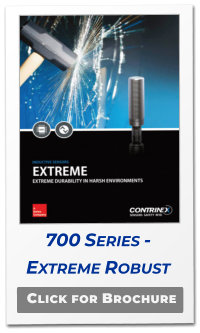
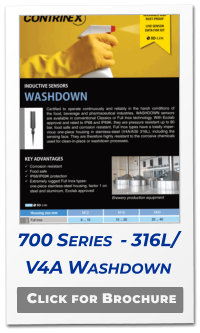
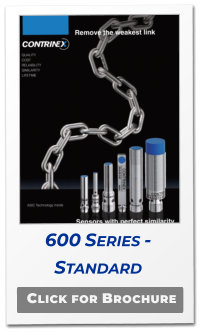
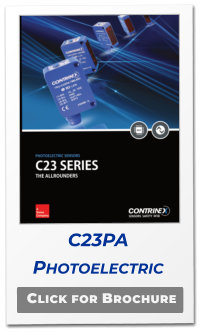
WELCOME TO PLUS AUTOMATION LTD - EXPERTS IN SENSORS, WE WILL WORK TO HELP YOU
SOLVE YOUR APPLICATIONS, IMPROVE MACHINE PERFORMANCE & RELIABILITY AND REDUCE COSTS
USING CONTRINEX’S EXCEPTIONAL SENSORS - LET US HELP YOU #MAKE SENSE OF SENSORS


Rugged sensor construction ensures excellent resistance to
shock and vibration and a sensing distance of up to 10mm
eliminates any risk of accidental collision with moving parts.
These devices are corrosion-resistant and impervious to water
ingress, mud, ice and salt. Reliability has been excellent.
Contrinex inductive sensors deliver a cost-effective solution
that satisfies the customer’s requirements for a simple, fit-
and-forget system.
The ‘700’ Series ‘Extreme’ sensors are uniquely robust sensors
are typically demonstrated by Contrinex as being able to
repeatedly being used to hammer in nails. Even when their
front face is dented, the sensor continues to operate correctly.
Even under the harsh operating conditions of this application,
these sensors last several years and downtime attributable to
faulty sensors is minimal. Their long service life contributes to a
reduction in repair costs.

--











CUSTOMER VALUES
ELIMINATION OF HUMAN ERROR PREVENTS TRUCK BEING
DRIVEN IN AN UNSAFE CONDITION.
HIGHLY RELIABLE SENSING PERFORMANCE IN HIGHLY
DEMANDING CONDITIONS
CORROSION-RESISTANT SENSORS WITHSTAND WATER, ICE,
MUD AND SALT
HIGHLY COST-EFFECTIVE SOLUTION TO A POTENTIALLY
SERIOUS PROBLEM
PRODUCT ADVANTAGES
EXTREMELY ROBUST, IMPACT AND ABRASION RESISTANT IP68/
IP69K RATED HOUSING.
CORROSION-RESISTANT, V2A/ AISI 304 STAINLESS-STEEL,
FOOD-COMPATIBLE BODY.
LONG OPERATING DISTANCE OF 7MM IN A SMALL & SLIM
STAINLESS-STEEL 20X 32X 8MM HOUSING.
ROBUST, METAL-CASED INDUCTIVE PROXIMITY SENSORS
SUITABLE FOR EASY INTEGRATION
FACTOR 1 - CONSISTENT SENSING, IRRESPECTIVE OF WHETHER
THE TARGET IS STEEL OR ALUMINIUM.
RELIABLE, COMPACT VIBRATION-RESISTANT SENSORS
IO-LINK INTERFACE INCLUDED – IDEAL FOR INDUSTRY 4
Hook loader trucks utilise a hydraulic system for loading and
unloading a demountable container. Once the container is
correctly positioned on the vehicle’s load bed, interlocks
engage with its base, securing it in position. Contrinex’s
rugged sensor systems detect full engagement of the
interlocks, ensuring the truck is safely loaded prior to driving
away. Therefore, the sensors must be mechanically robust and
able to withstand harsh outdoor conditions.
CUSTOMER APPLICATION
A specialist vehicle builder manufactures hydraulic hook-lift
systems for commercial trucks. A hook loader truck employs a
series of hydraulic rams to hook, lift and pull a demountable
container onto the vehicle’s load bed; a full container may
weigh up to 30 tons.
Hook loader trucks operate all year round, often in harsh
environments such as demolition and construction sites.
Hook-lift systems are typically semi-automated. The driver
positions the truck, engages the hook with the container and
initiates the lifting sequence. Once the container is pulled onto
the load bed, two interlock mechanisms, mounted on the
truck chassis, actuate and engage with the container body.
Once the interlocks are fully engaged, the container is secure
and the truck may be driven safely.
A highly reliable sensor system must detect the position of the
interlocks, ensuring that they are fully engaged before the
truck drives away. Sensors must be robust and must withstand
water, mud, dirt and ice. They may also be subject to
mechanical shock and vibration.
CUSTOMER SOLUTION
Rugged Full stainless-steel inductive sensors from the
Contrinex Extreme 700 Series are designed for demanding or
even exceptionally demanding environments, making them
ideal for this application. Highly reliable and IP68 / IP69K rated,
these embeddable units feature one-piece V2A (AISI 304)
stainless-steel construction with vacuum-encapsulated
electronics, making them well suited to the hostile operating
conditions.
During operation, a double-ended ram drives a pair of
interlock bolts into position. On either side of the truck, two
M18-diameter sensors are mounted in the wall of each bolt
housing; one detects the bolt as it reaches the fully engaged
position; the other detects it in the fully retracted position. A
second ram drives a rotating lock mechanism to engage with
the vehicle chassis; a further two sensors detect the position of
a cam on the locking shaft as it rotates.
Each sensor is configured with an industry-standard PNP
normally-open interface, and connection to the truck’s
hydraulic control system is via an integral M12 connector and
PUR-sheathed cable. This allows easy removal and
replacement during routine maintenance.

CUSTOMER VALUES
RELIABLE, EXCEPTIONAL RELIABILITY IN A HARSH OUTDOOR
ENVIRONMENT
AUTOMATIC OPERATION WITH OPTIMAL SPACE UTILISATION
ELIMINATION OF SWITCHING ERRORS DURING YEAR-ROUND
OPERATION
SIGNIFICANTLY REDUCED MAINTENANCE COSTS
PRODUCT ADVANTAGES
SENSING RANGE UP TO 12,000 MM
LONG SENSING RANGE IN SMALL SENSOR
EXCEPTIONAL RESISTANCE TO VIBRATION DURING OPERATION
When a tram reaches a road junction, wire-switches, installed
on the overhead conductor cables, control its direction of
travel, with switches in either the default “straight-through” or
“turnout” positions. As the tram passes a switch in the turnout
position, Contrinex photoelectric sensors mounted on the
overhead cables detect the presence of the pantograph
current collector so that the control system can then reset the
switch to the default position.
CUSTOMER APPLICATION
In urban tram transportation systems, wire-switches installed
on the overhead conductor cables at road junctions, control
the direction of travel for the trams. The switches default to the
straight-through position so that when a bus approaches a
turn, the driver uses a remote trigger to change the switch to
the turnout position. After the bus completes the turn, the
switch reverts to the straight-through position.
If a triggered switch reverts to the straight-through position
prematurely, the pantagraph current collector may become
disengaged, damaging the switch. Therefore tram operators
install safety systems to prevent premature switching.
Typically, these utilise timer circuits and a predetermined delay
or mechanical sensors that rely on physical contact with the
current collector, but neither system is reliable.
A Swiss manufacturer of trolley-bus control systems requires a
highly reliable, rugged sensor system that will detect the
presence of a current collector as it passes a switch. The
system must operate with minimal maintenance and
withstand the varied weather conditions of an outdoor
environment in Switzerland and therefore they selected
Contrinex sensors.
.
Customer Solution
Contrinex’s C23 through-beam photoelectric sensors offer
high-performance, small size and high-stability. A purpose-
designed metal bracket, mounted above the conductor cable,
holds the transmitter and receiver units in alignment on either
side of the cable. As the pantagraph current collector passes
between the two units it breaks the beam, triggering the
sensor and returning the switch to the straight-through
position.
The C23 photoelectric sensors are virtually impervious to the
harsh, outdoor environment and their small physically size (30
x 20 x 10mm) eliminates the risk of accidental damage arising
from a mechanical collision. The rugged construction and
vacuum-encapsulated electronics within the sensor minimise
the effects of vibration, ensuring a long service life.
Each unit is connected to the trolley-bus control systems via a
PVC-sheathed cable with a hermetically sealed entry. The
receiver has an industry-standard PNP interface. The one-
piece mounting bracket allows easy removal and replacement
of the complete assembly during routine maintenance.
Operational results have been excellent and the Contrinex
sensors have proved highly reliable, eliminating switching
errors and reducing maintenance costs significantly.
These rugged miniature sensors have a sensing range up to
30m, for Through-beam applications. They are very reliable
and cost-effective with the additional benefit of offering a
range of low-cost stainless-steel mounting and protection
brackets, making them ideal for a wide variety of applications.

CUSTOMER VALUES
SAFE, RELIABLE PERFORMANCE IN A DEMANDING OUTDOOR
ENVIRONMENT
NO LIKELIHOOD OF ACCIDENTAL DAMAGE ARISING IN
OPERATION
COST-EFFECTIVE SOLUTION, MAINTENANCE FREE
PRODUCT ADVANTAGES
CORROSION-RESISTANT STAINLESS-STEEL SENSOR RATED TO
IP68 AND IP69K
COST-EFFECTIVE HIGH-PERFORMANCE SENSOR WITH
EXCEPTIONAL RELIABILITY
BEST-IN-CLASS 20MM SENSING DISTANCE IN M30-DIAMETER
HOUSING
CUSTOMER SOLUTION
Contrinex inductive sensors are robust, reliable and offer
extended sensing distances; the Full Inox Extreme range is
ideal for this application. A one-piece M30-diameter stainless-
steel body and vacuum-encapsulated electronics make this
device particularly suitable for the mechanically demanding
environment, and the sensing distance of 20mm eliminates
any possibility of accidental collision in operation.
A metal bracket is mounted externally on the actuating
mechanism for the upper forks; the embeddable sensor is
mounted immediately adjacent to one of the forks and detects
the position of the actuating arm as it drives the fork into the
vertical position. The AISI 303/V2A stainless-steel housing and
sensing face are corrosion-resistant and impervious to water
ingress; the sensor is IP68- and IP69K-rated.
Configured with an industry-standard PNP normally-open
interface, the Contrinex M30 Extreme sensor connects to the
forklift’s lower-fork tilt-control systems via a flexible PUR-
sheathed cable. A sealed cable entry ensures fit-and-forget
capability during extended periods of operation in an outdoor
environment.
The Full Inox inductive sensor detects the vertical position of
the forklift’s upper forks effectively and repeatably, ensuring
safe, reliable operation of the unloading system. Contrinex
inductive sensors deliver a cost-effective solution that satisfies
the customer’s requirements for extreme robustness and
extended sensing distance
A container manufacturer uses a modified forklift, fitted with
two sets of forks, for unloading bulk cargo. The lower forks
support the container while the upper forks control the lid.
When unloading, the lid opens and the lower forks rotate,
tipping out the contents. A robust inductive sensor senses the
position of the lid, ensuring it opens fully before emptying.
CUSTOMER APPLICATION
Containers are often used when transporting bulk cargo,
including wood chip and biomass, by rail. A manufacturer of
bulk-cargo containers has developed an innovative unloading
system that uses only a modified forklift, eliminating the need
for specialist handling equipment.
The forklift has two pairs of lifting forks. The main forks,
mounted conventionally, support the weight of the container
as it is unloaded from a freight wagon; a second pair, mounted
vertically above the lower pair, opens and closes the lid of the
container. During opening, the upper forks lift the lid a short
distance before tilting it vertically, leaving the top of the
container completely unobstructed.
The lower forks then rotate about a horizontal axis, tilting the
container end-over-end and tipping the contents out. A robust
and reliable sensor system is required to detect the vertical
position of the lid before rotation begins. An extended sensing
distance is essential to eliminate the possibility of mechanical
damage.

CUSTOMER VALUES
RELIABLE, CONTINUOUS SPEED MONITORING IN HARSH
ENVIRONMENT
FIT-AND-FORGET SENSOR SOLUTION
EFFICIENT, COMPACT DESIGN POSSIBLE FOR MOBILE TURNING
MACHINE
NO SENSOR-RELATED DOWNTIME• NO REPAIR COSTS THANKS
TO EXCEPTIONALLY LONG SENSOR LIFE
PRODUCT ADVANTAGES
EXTREMELY ROBUST, IMPACT AND ABRASION RESISTANT IP68/
IP69K RATED HOUSING.
CORROSION-RESISTANT, V4A/ AISI 316L STAINLESS-STEEL,
FOOD-COMPATIBLE BODY.
LONG OPERATING DISTANCE OF 7MM IN A SMALL & SLIM
STAINLESS-STEEL 20X 32X 8MM HOUSING.
ROBUST, METAL-CASED INDUCTIVE PROXIMITY SENSORS
SUITABLE FOR EASY INTEGRATION
FACTOR 1 - CONSISTENT SENSING, IRRESPECTIVE OF WHETHER
THE TARGET IS STEEL OR ALUMINIUM.
RELIABLE, COMPACT VIBRATION-RESISTANT SENSORS
IO-LINK INTERFACE INCLUDED FOR FREE – IDEAL FOR
INDUSTRY 4
Agriculture is using increasingly complex automation in its
machinery and an example application is in composting
machines. Contrinex’s uniquely robust V4A/ 316L stainless-steel
sensors are relied upon for operating reliably in the
challenging environment of the inside of the machine’s drive
rotor. Withstanding dust, humidity and high temperatures, the
sensors enable the machine to provide the fast drying of
materials and optimal decomposition with reliable sanitisation
being ensured.
CUSTOMER APPLICATION
The efficient turning of organic materials – loosening, lifting
and aerating – is vitally important in industrial composting.
Special mobile equipment ensures fast drying of materials,
optimal decomposition and reliable sanitisation, processing
between 500 and 6800 cubic metres of earth per hour.
A manufacturer has introduced machine speed monitoring by
sensor. A sensor located in the rotor counts the passing teeth
of a rotating mechanical disk. From the number of teeth per
second, the controller then calculates the final speed.
Perfect sensor operation is required under these particularly
harsh conditions. In addition to permanent vibration and
shaking, the inductive sensor is also constantly exposed to
dust, moisture, and temperatures from 70 to 80°C (158 to
176°F). Since the location of the sensor in the rotor is hard to
access, the sensor must be very durable and low maintenance
to avoid time-consuming repairs.
CUSTOMER SOLUTION
Contrinex inductive sensors from the FULL INOX family,
Washdown range, are perfect for this application. Made from a
single piece of V4A stainless steel, including the sensing face,
they have no covers, caps or welding seams and are the most
robust inductive sensors on the market. They resist shock,
vibration, impact and abrasion and almost any exposure to
dirt, gases, or liquids such as oil, water and cleaning agents.
Functionally stable at temperatures from -25 to +85°C (-13 to
185°F), they are also insensitive to core breakage.
Thanks to the long operating distances of these sensors (three
times greater than the norm) a compact and efficient design
was possible using the M12 size. A long operating distance
allows the sensor to be mounted well away from the rotating
disk’s passing teeth. Setup is also straightforward, as
installation tolerances are less critical. A sensor version with
plug connector was chosen to allow speedy replacement if
necessary.

CUSTOMER VALUES
MAXIMUM VEHICLE UTILISATION WITH FEWER CONSTRAINTS
ON OPERATIONS
REAL-TIME INDICATION OF BEARING CONDITION AND WEAR
RATE
REDUCED MAINTENANCE COSTS WITH MINIMAL INCIDENCE OF
BREAKDOWNS
RELIABLE OPERATION IN A HIGHLY DEMANDING AND HARSH
ENVIRONMENT
PRODUCT ADVANTAGES
ANALOGUE DEVICE WITH EXTENDED 40MM SENSING RANGE
SMALL PHYSICAL SIZE (LESS THAN 50MM LENGTH)
EXCEPTIONAL ACCURACY AND RESOLUTION IN THE MICRON
RANGE
LONG LIFE, ESPECIALLY IN APPLICATIONS WITH TEMPERATURE
FLUCTUATIONS AND VIBRATIONS
Busy container seaports rely upon the ‘24/7’ operation of
specialist container-handling vehicles called Straddle Carriers
for loading, unloading and stacking containers. Often located
at ports, being beside the sea can mean that they have to work
in an aggressive and corrosive environment, requiring
frequent maintenance.
Because traditional, interval-based maintenance schedules are
not optimally efficient, condition-based intervention systems
which minimise the risk of breakdown, are popular. European
port operators therefore frequently rely upon Contrinex’s
rugged, analogue-output inductive sensors to monitor
components with a high risk of premature failure, maximising
vehicle utilisation and reducing maintenance costs.
CUSTOMER APPLICATION
A fleet of straddle carriers services a busy container port,
operating round the clock in a highly aggressive environment.
Frequent maintenance is necessary, but traditional, interval-
based maintenance schedules are not always optimal.
Condition-based intervention minimises the risk of
breakdowns, while imposing fewer constraints on day-to-day
operation; it also incurs cost only when necessary.
As a carrier moves over a container, a central spreader beam
lowers and locks onto the four corner fittings of the container.
Plain plastic bearings on the carrier legs guide the container as
it is raised; there is significant contamination from dirt and
other debris. Bearings wear rapidly in the all-weather
operating conditions.
A condition-monitoring system must measure bearing
thickness, repeatably and accurately, in realtime and with µm
resolution. Sensors must operate reliably in the harsh
environment with a minimum rating of IP67. Sensor length
must not exceed 70mm and a minimum sensing range of
30mm is mandatory.
CUSTOMER SOLUTION
Contrinex’s Analogue Inductive sensors, which feature ‘Extra
Distance’ technology are ideal for this demanding application.
These M30-diameter metal-bodied devices are IP67-rated and
provide an analogue voltage (0 to 10 volt) or current (4 to
20mA) output. The sensors are less than 50mm long with a
40mm sensing range, comfortably exceeding the specified
requirement.
A mild steel mounting plate, fixed immediately behind the
plastic bearing, locates each sensor with its sensing face in
contact with the rear surface of the bearing. As a container
passes over the front face of the bearing, the sensor measures
the distance to the metal container wall, and thus the bearing
thickness. Data is collected in real time with exceptional
accuracy and resolution in the micron range.
Data passes to on-board computers mounted on each carrier;
connection is via a flexible cable with an easily detachable M12
connector. At intervals, carriers transmit data wirelessly to a
central processor for detailed analysis.
The output gives a clear indication of the condition and wear
rate of each bearing, identifying any carrier requiring
maintenance. Consequently, the port operator has the means
to develop a genuine commercial advantage by eliminating
compromise from day-to-day operating processes

CUSTOMER VALUES
UNINTERRUPTED PRODUCTION AS POSITIONAL
IDENTIFICATION IS HIGHLY RELIABLE.
NO RISK OF SKEWING AS MOVEMENT OF THE MACHINE
STRUCTURE IS SYNCHRONISED.
ELIMINATION OF COLLISION DAMAGE BECAUSE OF SENSING
DISTANCE UP TO 45MM.
PRODUCT ADVANTAGES
PASSIVE RFID TRANSPONDER TAGS REQUIRE NO POWER
SOURCE AND MINIMAL MAINTENANCE.
RUGGED RFID TRANSPONDER TAGS WITH NYLON OR ALL-
METAL HOUSINGS SEALED TO IP67.
CONIDENT® TECHNOLOGY PROVIDES EXTENDED SENSING
RANGE ≤ 45MM.
READ/WRITE UNITS INTERFACE WITH A CHOICE OF INDUSTRY-
STANDARD CONTROL SYSTEMS OR IO-LINK
CUSTOMER SOLUTION
Contrinex high-frequency RFID read/write modules and
30mm-diameter RFID transponder tags are ideal for this
application. Rated up to IP67, the M30-diameter read/write
modules have PBTP sensing faces and V2A stainless-steel
housings, making them ideal for the demanding environment.
The ConIdent® passive transponders require no internal power
source and, with PBTP synthetic housings, have the same IP67
rating. The selected combination provides read/write distances
of up to 45mm (nearly 2 in), ideal for the specified operating
conditions. Tags are mounted at one-meter intervals along
each travel rail, each programmed with a unique identification
number.
As the machine passes a tag, the read/write module reads its
identification number at high speed; this is transmitted via a
PROFIBUS DP interface to the customer’s control system. A
simple look-up table confirms the location of the tag and thus
the position of the machine, allowing movement of both sides
of the structure to be synchronized without skewing.
Operation is independent of the direction of travel.
Contrinex ConIdent® RFID devices allow accurate and highly
reliable sensing of machine position and the long sensing
distance avoids any risk of collision damage. The customer
enjoys extended service life and robustness not available from
alternative position-detection systems, together with excellent
value for money
A manufacturer of bulk material-handling equipment uses
Contrinex Radio Frequency IDentification (RFID) technology to
sense the position of a large rail-mounted reclamation-
conveyor operating in a hot, dusty environment. A pair of read-
write modules, mounted on the machine structure,
interrogates a series of RFID tags, positioned at one-meter
intervals along each travel rail. The control system identifies
each tag individually and determines the exact position of the
machinery.
CUSTOMER APPLICATION
During surface-mining operations, large mobile reclamation
machines are used to recover bulk materials. On each
machine, a bucket-wheel excavator collects material and
deposits it onto a conveyor. As an area is cleared of material,
the machine moves along parallel steel travel rails to the next
area, allowing continuous operation without interruptions for
machine repositioning.
The distance between the travel rails is around 100 metres (300
ft) and travel speeds may reach 2m/sec (4.5 mph). If machine
movement along the two rails is not controlled accurately, the
two sides of the structure become misaligned, causing the
machine to skew. In this event, production is halted while the
machine is realigned; in the worst case, costly damage occurs.
A sensing system is required that detects the position of each
side of the machine structure accurately and reliably along the
entire length of the travel rails, allowing coordinated control of
the drive systems. Sensors must accommodate up to 10mm
lateral movement of the machine structure across either rail
and must withstand the hot, dusty environment of a desert
climate.
I

CUSTOMER VALUES
NON-CONTACT, ALL-ELECTRONIC DEVICE WITH SENSING
RANGE UP TO 500MM.
LARGE SENSING RANGE AVAILABLE IN A PHYSICALLY SMALL
SENSOR.• EXCEPTIONAL RESISTANCE TO EXTREME VIBRATION
DURING OPERATION.
OPTIMAL SPACE UTILISATION WITH LITTLE OR NO RELIANCE
ON OPERATOR INVOLVEMENT
PRODUCT ADVANTAGES
ELIMINATION OF CALIBRATION ERRORS DURING NORMAL
OPERATION
LARGE SENSING RANGE AVAILABLE IN PHYSICALLY SMALL
SENSOR
PROVIDES RELIABLE, REPEATABLE SENSING IN DEMANDING
OPERATING CONDITIONS
At busy container seaports, purpose-designed container-
handling vehicles called Straddle Carriers, operate around the
clock, loading, unloading and stacking containers. Space
utilisation is increasingly important and correctly identifying
the size of container picked for each lift is essential for
efficiency.
Contrinex photoelectric sensors have been fitted to the
Straddle Carriers to detect the container size and eliminate the
need for drivers to carry out identification checks, saving time
and avoiding errors.
CUSTOMER APPLICATION
A fleet of straddle carriers, purpose-designed container-
handling vehicles, services a busy French container port. As a
straddle carrier moves over a container, a central lifting beam
lowers and locks onto the corner castings of the container;
each lift comprises either a single 40-foot container or two 20-
foot containers.
Optimal utilisation of storage space is essential; correctly
identifying the size of container picked for each lift is vital.
Fitting carriers with sensors that detect the size and type of
containers at the time of lifting eliminate the need for drivers
to carry out identification checks, saving time and avoiding
errors.
The original mechanical sensors proved unreliable, losing
calibration when subjected to continuous vibration during
normal operation. Although the scheduled maintenance
interval for each vehicle is 1,000 hours, mechanical sensors
required recalibration at intervals of no more than two or three
days. A highly stable replacement sensor system was required.
CUSTOMER SOLUTION
Highly stable, non-contact, all-electronic units from the
Contrinex range of photoelectric sensors provide a reliable and
cost-effective alternative. The moulded-resin sensor casings,
fitted with coated-plastic sensing faces, are IP67 rated, making
them virtually impervious to the harsh, salt-laden environment
of a busy container port. Connection to the vehicle’s control
systems is via an integral M12 connector and PVC-sheathed
cable, allowing easy removal and replacement during routine
maintenance.
To confirm the size of the container, two pairs of diffuse
sensors with background suppression are mounted centrally
on each lifting beam. As the lifting beam descends, one sensor
from each pair detects the presence or absence of corner
castings at the central lifting points, while the other detects
the presence or absence of the gap between two 20-foot
containers. The combination of the two eliminates incorrect
identification in the unlikely event that the first sensor returns
a false-positive signal from a 40-foot container.
A physically small housing and long sensing distances
eliminate the risk of accidental damage arising from a
mechanical collision, while rugged industry-standard housings
and vacuum-encapsulated electronics minimise the effects of
vibration.
Operational results have been excellent; the new Contrinex
sensors have eliminated calibration errors and reduced
maintenance costs significantly.
A range of multi-purpose off-road tractors allows the driver to
choose between two-wheel or four-wheel steering. When
selecting two-wheel steering using the front wheels only, the
rear axle is locked in the straight-ahead position. Before the
axle is locked, rugged inductive sensors from Contrinex detect
the straight-ahead position accurately and reliably, ensuring
precise alignment of the tractor’s steering geometry.
CUSTOMER APPLICATION
Modern multi-purpose off-road utility vehicles are
exceptionally versatile, offering four-wheel drive and both front
and rear-wheel steering. Reliable operation all year round, on
all types of terrain and in all weather conditions, is essential as
typical tasks include bulk-load transportation and agricultural
engineering.
Extreme conditions often demand increased manoeuvrability;
for maximum control, the driver can engage four-wheel
steering when required. When reverting to the default two-
wheel steering configuration, the rear axle must be locked in
the straight-ahead position to prevent misalignment of the
rear wheels.
A rugged, reliable and accurate sensor system is required to
detect the straight-ahead position of the rear axle before it is
locked. The sensor must withstand significant mechanical
shock and vibration and must also be impervious to water
ingress. Additionally, it should accommodate the extremes of
temperature experienced during all-year-round operation.

CUSTOMER VALUES
RELIABLE, REPEATABLE SENSING PERFORMANCE IN
DEMANDING OPERATING CONDITIONS
FIT-AND-FORGET OPERATION WITH MINIMAL MAINTENANCE
TECHNICALLY ELEGANT, COST-EFFECTIVE SOLUTION
REQUIRING MINIMAL RE-ENGINEERING
PRODUCT ADVANTAGES
2MM SENSING DISTANCE ELIMINATES THE POSSIBILITY OF
ACCIDENTAL DAMAGE TO THE SENSOR
RUGGED, ROBUST STAINLESS-STEEL SENSOR WITH INTEGRAL
M8 CONNECTOR
AFFORDABLE HIGH-PERFORMANCE SENSOR WITH
EXCEPTIONAL RELIABILITY - FIT-AND-FORGET OPERATION
WITH MINIMAL MAINTENANCE
Configured with an industry-standard PNP normally-open
interface, the sensor features an integral M8 connector and
connects to the vehicle’s central controller via a flexible PVC-
sheathed cable. Adding the sensor requires minimal
modification to the vehicle’s control systems, and
maintenance is simple and speedy.
The sensor detects the straight-ahead position of the vehicle’s
rear axle repeatably and accurately, ensuring correct, reliable
engagement of two-wheel steering. Contrinex inductive
sensors provide the customer with a cost-effective fit-and-
forget solution to a challenging problem.
CUSTOMER SOLUTION
Inductive sensors from the Contrinex ‘Basic’ range are rugged,
reliable and accommodate the required extremes of
temperature; with an M8-sized sensor being ideal for this
application.
A V2A/AISI 303 stainless-steel body and vacuum-encapsulated
electronics, make it particularly suitable for the mechanically
demanding environment, and it is rated for operation at
temperatures between -25ºC (-13ºF) and 70ºC (158ºF).
A narrow flange is attached to each end of the vehicle’s
hydraulic power-steering rack. The sensor is mounted
immediately below one end of the rack and detects the
position of the flange as it passes over the sensing face. The
sensing distance of 2mm eliminates any possibility of
accidental collision with the flange.

CUSTOMER VALUES
RELIABLE OPERATION DESPITE HIGH-OPERATING PRESSURES
EASE OF MOUNTING
REDUCED MAINTENANCE COSTS
INCREASED EFFICIENCY
PRODUCT ADVANTAGES
PRACTICALLY UNLIMITED NUMBER OF PRESSURE CYCLES
ACROSS THE PRESSURE RANGE – 10 TIMES GREATER
LONGEVITY THAN THE MARKET STANDARD
PEAK PRESSURE UP TO 1000 BAR (14500 PSI)
LONG OPERATING DISTANCES DESPITE PRESSURE RESISTANT
HOUSING
RESISTANCE TO DYNAMIC STRESSES
Manufacturers of mobile concrete pumping trucks trust
Contrinex’s High Pressure sensors to monitor the piston
position in the hydraulic drive cylinder.
These sensors provide exceptional reliability despite the
challenges of pressure cycles and high pressure peaks,
increasing longevity and efficiency and reducing maintenance
costs for these concrete pump.
An additional benefit is that these sensors are part of
Contrinex’s Extra Distance family and so combine long
operating distances despite the pressure resistant housing.
CUSTOMER APPLICATION
Concrete pumps use a double-piston pump and require two
feed cylinders that pump concrete at a working pressure of up
to 400 bar (5800 psi). These feed cylinders are driven by pairs
of hydraulic cylinder pairs which operate in push-pull
opposition. To achieve the maximum possible efficiency, the
timing of this push-pull operation must be precisely
coordinated. It is therefore essential to monitor the cylinder
limit position with sensors that are resistant to high pressure.
The dynamic stresses on all components built into the
hydraulic system are very high, due to constantly changing
pressure cycles during pump operation.
Concrete pump failures are extremely costly because they can
cause construction problems and stoppages and risk
compromising the building being constructed.
If the breakdown is due to problems in the hydraulic system,
all the hydraulic oil must be drained to correct the fault. Then,
after refilling and before start-up, several time-consuming de-
aeration cycles must take place before the pump is fully fit for
service again. This prolongs the construction stoppage.
The customer’s requirements for longevity and resistance to
high peak pressures are essential to guarantee the smooth
operation of such systems.
CUSTOMER SOLUTION
Contrinex High-Pressure sensors (series 500P) withstand the
necessary pressure levels (peak pressure up to 1000 bar - 14500
psi) due to a patented process whereby a solid ceramic disk is
built into the stainless steel housing.
These sensors are fully resistant to dynamic stresses. A
patented technology ensures that all electronics, including the
ferrite core and coil, are located on the unpressurised side of
the housing. This results in an unusually long life under
pressure cycle stresses.
To monitor cylinder limit positions in the concrete pump, two
sensors are installed and connected to the control system. Due
to their longevity, which is ten times greater than the market
standard, maintenance costs are reduced to a minimum.
OFF-HIGHWAY & RAIL
APPLICATIONS
FOR MANUFACTURERS TO PLACE THEIR TRUST IN
TEST AND INSPECTION EQUIPMENT, THEY NEED TO
BE CONFIDENT IN THE SENSORS THEY USE -
CONTRINEX’S DURABILITY, RELIABILITY, AND HIGH-
PERFORMANCE THEREFORE MAKES THEM IDEAL.
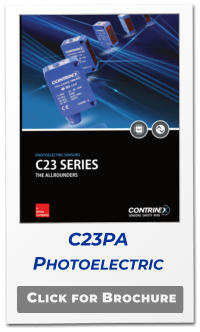
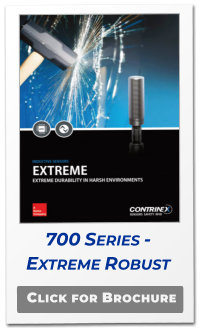
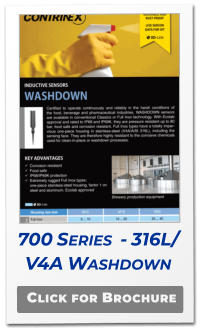
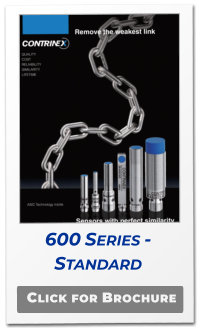
WELCOME TO PLUS AUTOMATION LTD - EXPERTS IN SENSORS,
WE WILL HELP YOU SOLVE YOUR APPLICATIONS, IMPROVE MACHINE
PERFORMANCE & RELIABILITY AND REDUCE COSTS USING CONTRINEX’S
EXCEPTIONAL SENSORS - LET US HELP YOU #MAKE SENSE OF SENSORS



Rugged sensor construction ensures excellent resistance to
shock and vibration and a sensing distance of up to 10mm
eliminates any risk of accidental collision with moving parts.
These devices are corrosion-resistant and impervious to water
ingress, mud, ice and salt. Reliability has been excellent.
Contrinex inductive sensors deliver a cost-effective solution
that satisfies the customer’s requirements for a simple, fit-
and-forget system.
The ‘700’ Series ‘Extreme’ sensors are uniquely robust sensors
are typically demonstrated by Contrinex as being able to
repeatedly being used to hammer in nails. Even when their
front face is dented, the sensor continues to operate correctly.
Even under the harsh operating conditions of this application,
these sensors last several years and downtime attributable to
faulty sensors is minimal. Their long service life contributes to a
reduction in repair costs.
















